|
Support Ghost Guns
|
Miss Ellie: Remembering the Ladies
Interviewed by Barbara Peterson
While the mandate of Ghost Guns Virginia is to cover the historical scene in Virginia, we also conduct interviews with historians, re-enactors, and other people of interest around the country.
Ellen M. DiMaggio has been speaking about the ladies of the Civil War era to the school children, and others, of Arkansas for almost ten years, as you can see from her website, www.speakingofladies.com/.
If you're in need of a period dress or gown, make sure you visit Miss Ellie's Emporium,.
|
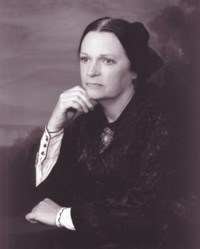 Ellen DiMaggio Ellen DiMaggio |
| Please give us some biographical data.
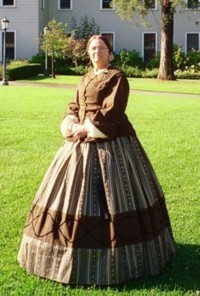
|
I was born and raised in northwest New Jersey, Sussex County, a small dairy farm community, on March 21, 1952.
My parents owned a small "mom and pop" luncheonette on Main St. We lived upstairs. I grew up as one of the "downtown kids" and we had our fun playing in the empty lots behind the businesses. All of us lived over our stores. I have one older brother, Ken, who still lives in New Jersey and is an elementary school music teacher.
As a family, we spent many weekends camping to get away from the store, I guess that's where my appreciation for nature and the balance of life came from. We lived on the old Morris Canal and my favorite grown-up was Miss Elizabeth Bryant, our librarian. She always had stories to tell about the Revolutionary War, inclined planes, and how the canal boats drifted up and down behind our house.
We quite often visited historic sites in and around New Jersey, including the place where Washington crossed the Deleware, Ft. Ticonderoga, and
in 1961, we were part of Wagon Train West, a convoy of travel trailers crossing the country in celebration of NJ's tri-centennial birthday. We dressed in frontier costumes and were greeted by dignitaries in cities named "Salem" all the way to Salem, Oregon. This was a major event sponsored by Rutgers University.
Pretty much fun for a small town family with parents who had only an elementary school education. |

| When did you move to Arkansas?
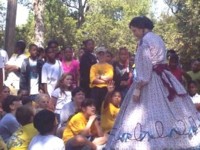
|
My husband's job offered us the opportunity to move out of New Jersey. In 1983, our first relocation brought us to Ft. Gibson, Oklahoma where we learned to live "western style". We loved the change.
Then in 1985, we moved to Gilbert, Arizone, a suburb of Phoenix. Another major life style change for all of us. By then we had five children and it was difficult letting them spend much time out of doors because of the heat. So we left his company, Revlon, and took on a position with Uncle Ben's Rice in Greenville, Mississippi. We bought a lot on Lake Chicot, Lake Village, Arkansas, just a short drive from Mississippi. We have lived here 19 years. |

| Your study of women's roles began when you found the autobiography of Belle Boyd, a Confederate
spy, at a junk sale. When did this occur?
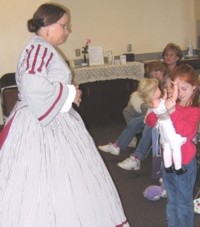
|
It was 1996. We were building a new home and I was interested in decorating with old books. This book looked old, was dated 1869 and I thought, "Hmmm, I can afford $1.00 for this book." When I got home and discovered what it was, I saw the first few pages of the introduction were torn out. Being a library manager at the time, I was able to acquire an intact copy of the book and began to read about the famous Belle Boyd, Confederate Spy.
Much to my surprise, I discovered the newspaper articles inside [articles contemporary with Belle Starr], plus some line drawings of a woman wearing a hooped skirt, and I tried to read the inscription on the fly leaf. Could this be HER initials? I made a copy of them and sent it to the Belle Boyd museum in West Virginia, but nothing was decided in regards to the signature. I made copies of the news articles and sent them along, too.
Thus began my interest in women's history, especially associated with the War Between the States. |

| Between the pages were stuffed several newspaper articles referring to Miss Boyd in the present tense! Do you still have these articles? What papers were they from, and by any chance have you scanned them and put them on the web?
|
I still have them, I use them in my programs because someone always asks how I got started in this.
No indication from what papers they come. The book seller's stamp is from Natchez, Mississippi. I know Belle was in that city. There is a family name written, but I've never tried to investigate further. I have scanned them and used them as a handout for a performance on Confederate Spies for the Belle Boyd Chapter of the UDC. |

| You're compiling an Honor Roll of women of 1860-1880 who have been forgotten to history. How do you go about conducting your research?
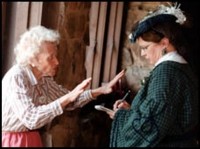
|
This is a secondary project that came about as a result of my research for my shows. As I discover a new lady, I make a note on the computer. I had so many notes, I began keeping an index, which led to chapter-izing (is that a word?) the information.
All 950 women [currently in database] are in my files and for organization, I had to format it like a book. I'm not a writer, so the chance of publishing this encyclopedia of women in history is pretty slim.
I do all my own research, I'm the only one who knows what I'm looking for. Additionally, as I travel around speaking with groups, invariably, someone offers their ancestor's journal for my inspection. It is amazing to read these first person accounts of what it was like to live in the 19th century, from the woman's perspective. I read and read and read.
Being a former library manager, my connections allow me access to out-of-print books otherwise not loaned to the general public. Using the internet has helped locate photos of my ladies. |

| How did you get the idea to do you very first presentation? When did you do it? I see on your
website that you've got 7 programs that you do. Do you have a chronology of when each one was created and first performed? Which is the most popular?
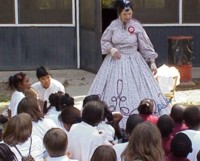
 . .
 . .
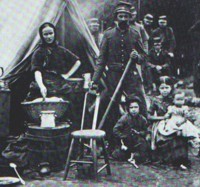
 . .
 . .
|
Since I was working in a the county library in our little town, I was very active in public outreach programs. One of my associates was the state park interpreter. Lake Chicot State Park hosted an annual Civil War Days and I was asked to help with school day.
"Can you just put together 20 minutes of information about whatever it is you do and come out to the park to talk with the kids?" So I did. My first experience was a shock to me. It was so natural for me to speak to the children about what it was like to be living in Lake Village when the Yankees came to town.
The biggest shock I got was the revelation that I was referring to the Yankees as "them", not "us". Remember, I was born a Yankee. It was invigorating to see the reaction of the students to find out women were instrumentally involved in the Civil War. I was hooked.
I began seeking out ways to do this same outreach program for other venues. The more I learned about the women, the longer and longer my show became, until I realized no one wanted to sit and listen to me talk for 2 hours. That's when I analyzed my show and began to dissect it into 45-60 minute formats. As a performer, I could see I had many different age groups and interest levels in my audiences, so I learned to be flexible in my presentations. If I'm not having fun, I know the audience isn't either.
Each year I try to bring out a new program. The first and most entertaining is the unconventional roles women played in the War Between the States-"For Weal or Woe". That takes you on a journey from uniform making and fund raising, through nursing, smuggling, spying, soldiering and finally, termination of the war. The second spin-off is "What's up with that dress?", 19th century wardrobe. So many times the question arises, "how do your dresses stick out?" I wasn't about to show my undergarments, so I found a doll to be my model and with Miss Anna Belle Leah's help, we discuss what it was like to be a lady, with all the garments, protocols, rituals, and lifestyles. Having the doll makes the subject matter less threatening for the males in the audience, and I've had wonderful feedback from them.
The next spin-off was "Corsets to Congress" because I found a lot of these women who were instrumental in the War effort went on to be reformers for the women's movement. After most wars, women's roles change dramatically, and the War Between the States was no different. New opportunities were opened for women and their stories amaze me every time I present this show.
In 2004, I had the great honor to participate in the Hunley Funeral in Charleston, SC. I had to record that experience and was able to share the perspective of a widow in the procession through this short program.
Next, I stumbled across my first Victorian Trade card. Not being the casual collector, I jumped in with both feet to research the origin and purpose of these beautiful cards. I was obsessed with yet another part of 19th century life. This developed into a comprehensive discussion of marketing techniques used in a time without TV or radio or even magazines.
While working in the library, I found a book on our shelf called "Confederate Women of Arkansas". Obviously intrigued, I took it home to read. It is the written, first hand accounts of what the war brought to the women in Arkansas, a recorded history similar to the Slave Narratives. The information in this book was horrifying. I couldn't sleep at night. I kept hearing the women crying out to me to tell their stories. I was forced to learn how to use Power Point so that I could do justice to the program.
A friend's recording of "The Water is Wide" became the springboard for the theme, being that Arkasas's rivers were so important to the War. After months of writing and re-writing, adding music, voice overs, "The Wound Has Never Healed" debuted in Oct. of 2003. It is a graphic show, suitable for mature audiences because of the horrific scenes described by the women. It was recently presented before the National Women's History Project's annual conference in Little Rock, Arkansas where it was viewed by a national audience. It stirred up quite a controversy, with comments like, "I never knew it was that bad."
Through the years, I have been asked to perform for many various organizations, markets, and venues. As a result, my programs have evolved, rotated, and turned upside-down in order to address the needs of the audience. "Ladies, Why are you here?" is one such program. The reenacting community is opening its doors to women participants. It is a pet peeve of mine to see 21st century women trying to adapt this historical activity to their modern day attitudes. Hence, I put together a "how to" program for the woman who wants to participate while maintaining historical accuracy.
I guess my favorite program is still the unconventional roles because it introduces the audience to so many interesting women. I provide a spark for their further investigation. It is a fun show, an emotional show and a poignant show. The audience gets pulled into the program, too, with interactive segments. |

| You make all your own costumes. How long does that take?
|
Most of my costumes take 10-15 hours to construct, however, weeks to design.
When I decide to make a new outfit, I look through my 19th century fashion magazines, Godey's, Petersons, Harpers, etc. until I find something that catches my eye. Then I look for an appropriate fabric. As I work on a dress, the trims and detailing reveal themselves to me and I become an artist at work.
Making a garment is like sculpting a piece of marble, the finished piece evolves throughout the process. |

| You're a former teacher and public library manager. Please give some background.
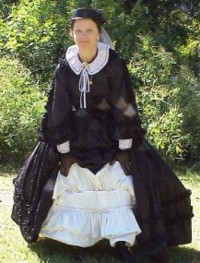
|
I taught in a state institution for the mentally retarded in New Lisbon, New Jerset. My program was an innovative concept of teaching children how to play, play therapy, because education is built upon the fundamental skills learned through playing. Since most of my students had been institutionalized at birth, most had no play experience.
My classes were made up of students from ages 6 to 19, all on a sub-trainable level of education. It was an exciting challenge to teach in this setting, with complete freedom to try to introduce the children to the joys of learning.
I resigned after 2 1/2 years to become a full time mother. Much later, I went back to teaching computer applications in our local Catholic school, then did some substituting in our public school. I guess I've always been an educator, and Miss Ellie helps keep me teaching, outside a classroom.
Thank you Miss Ellie for this interview. |

| |















